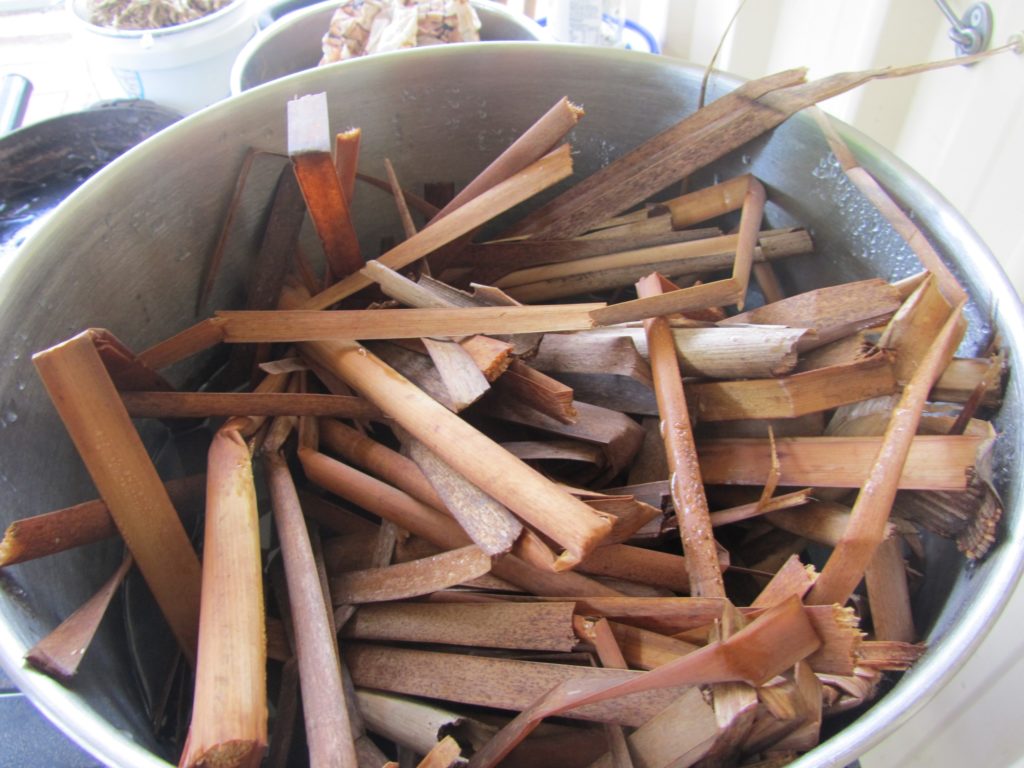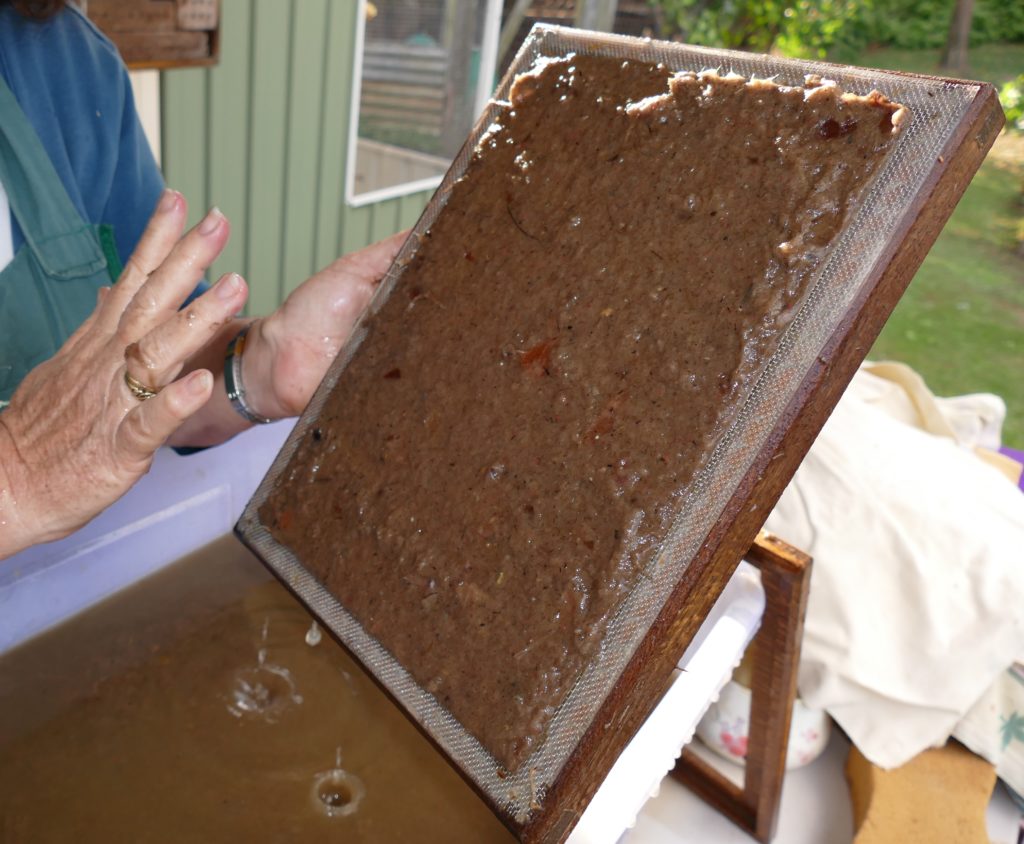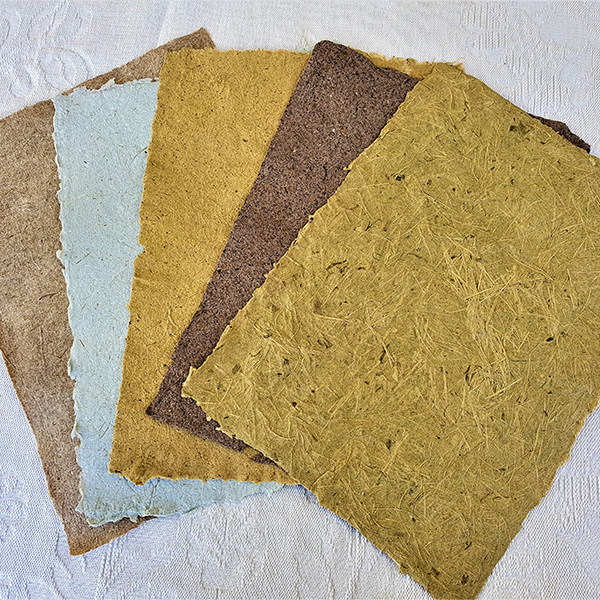Lesa Bell interviews Zela Bissett about her arts practice and papermaking among the gardens that inspire her and provide some of the raw materials for her artworks.
Zela Bissett’s studio has been a popular attraction over the years at Gympie’s Studio Trails. Zela reports that when visitors arrive they would often be as interested in the garden as the artworks. “In the end I started offering garden tours at set hours so people know when to arrive!” Lesa Bell visited Zela’s garden to see the plants that help her to make her unique papers and paper sculptures.
Lesa: I heard from other studio trail visitors that part of the thrill of visiting your studio is its setting among the permaculture garden.
Zela: Visitors do seem to like it. I remember one young lad who didn’t want to do the studio visit and was kind of dragged along by his Mum. I let him pick some ripe 5-corner (carambola) fruits from the tree and eat them. He loved it so much he told his Mum at the end of the visit, “We should come here more often!”
Lesa: How long has it taken you to set up this garden?
Zela: I have been working on this garden since we moved here over 18 years ago. I brought some special plants from my previous property including this seedling variety of Emperor mandarin that I got from friends of Bill Mollison nearly 40 years ago. Other varieties of lettuce we have been growing and saving seed for twenty years!
Lesa: How did you get onto papermaking?
Zela: I was always interested in collage and book arts and I joined an organisation called Papermakers of Queensland. I had some knowledgeable mentors such as Judy Barrass and I found out that you can make paper directly from plants! I was hooked!
Lesa: I heard your talk at the Gympie Garden Expo about how making papers has become part of a seasonal cycle of weeding and pruning. What are some of the plants you have used to make paper?
Zela: The part of plants which make the paper are the long cellulose fibres. So the plants have to be cooked to soften the fibres and remove fleshy bits. Some of my paper-making experiments have been quite unexpected. For instance when I cleaned out the frog pond it was quite choked up with an aquatic plant called dwarf papyrus. It is stalky plant so I decided to give it a try. It made a successful paper without too much cooking and preparation.
Lesa: So plants take different amounts of cooking and preparation?
Zela: Yes, each year when I cut back the Warrigal greens I set aside a portion for paper-making. It is a very tough fibre and never really softens up, but I persevere because people are really interested in papers that come from edible native plants, and it is one of the few plants that retains a greenish colour. One of my most reliable and readily prepared fibres is banana, and there is always a steady supply of that because the tree only every bears one bunch.
Lesa: Banana? What part do you use?
Zela: I started with the peelings from the trunks, but one of my gurus from the papermakers group told me that actual trunk makes the best paper. After the bunches are cut off, I put the sections through my Hansa chipper a couple of times, then soak the pulp and cook it down. I even grow a variety called Red Dacca because of its lovely papermaking fibres. All stalky plants like ginger, galangal, turmeric, cardamom can be successfully made into paper. Many native plants such as lomandra , bulrush (cumbunji) and dianella also make good paper.
Lesa: What about weeds? Could papermaking be a way to use environmental weeds?
Zela: Yes, as long as they are a stalky fibrous plant. I have a funny story about my friend Joolie’s attempt to make paper from Salvinia, an aquatic weed. She got in a bit of trouble for moving a pest plant! It made some interesting paper though! After that another friend brought me some bags of green algae from cleaning out her cattle drinking troughs. That made paper too but even though it was years ago, that paper still retains a swampy smell.
Speaking of weeds, There’s been a lot of interest in making baskets from cat’s claw vine, as it has been so rampant in recent years. I have been experimenting with other uses for cat’s claw vine including making twisted twine string.
Lesa: String? What else can you make from garden products?
Zela: Well we had to prune one the of the carob trees that was overshadowing other fruit trees, and I made some wooden buttons which I will use on wearable art outfits. I also make containers from palm fronds and experiment with kombucha pellicle. If you’ve grown kombucha the cultured drink, you will know that it gets a fleshy layer on top which can be made into a number of products. I used this in an exhibition in Bundaberg Regional Gallery called Plea For Plankton. I make works from biodegradable materials to show that we do not need to be using such huge amounts of petroleum based plastics, many of which end up in our oceans.
Lesa: I see you have a lot of Aloe vera here. Can that make paper?
Zela: No, it isn’t fibrous enough. But some plants are useful in other ways. Aloe vera is too fleshy to make paper on its own, but the gel is useful in keeping fibres in suspension in the vat while forming the paper sheet. I also think it reduces the irritation of some fibres like sisal which can make my hands itchy. Okra is another plant which produces a gel that keeps fibres in suspension. Parts of other plants are useful in decorating the papers. I keep an eye out around the garden for skeletonised leaves which can be pressed into the paper. Little tendrils from passionfruit and loofahs look attractive as decoration too. I try to keep an artist’s eye on all the variations of leaves, vines, seeds and flowers as the seasons change. I call it my mindful gardening, which feeds directly into my arts practice.

Lesa: You have so many plants it must be interesting all year round. Thanks for letting me visit your studio and garden.
Zela: It’s a pleasure!


0 comments on “Sneak-Peek in the studio”